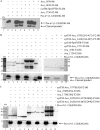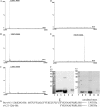Identification and characterization of five intramembrane metalloproteases in Anabaena variabilis
- PMID: 22961855
- PMCID: PMC3486370
- DOI: 10.1128/JB.01366-12
Identification and characterization of five intramembrane metalloproteases in Anabaena variabilis
Abstract
Regulated intramembrane proteolysis (RIP) involves cleavage of a transmembrane segment of a protein, releasing the active form of a membrane-anchored transcription factor (MTF) or a membrane-tethered signaling protein in response to an extracellular or intracellular signal. RIP is conserved from bacteria to humans and governs many important signaling pathways in both prokaryotes and eukaryotes. Proteases that carry out these cleavages are named intramembrane cleaving proteases (I-CLips). To date, little is known about I-CLips in cyanobacteria. In this study, five putative site-2 type I-Clips (Ava_1070, Ava_1730, Ava_1797, Ava_3438, and Ava_4785) were identified through a genome-wide survey in Anabaena variabilis. Biochemical analysis demonstrated that these five putative A. variabilis site-2 proteases (S2Ps(Av)) have authentic protease activities toward an artificial substrate pro-σ(K), a Bacillus subtilis MTF, in our reconstituted Escherichia coli system. The enzymatic activities of processing pro-σ(K) differ among these five S2Ps(Av). Substitution of glutamic acid (E) by glutamine (Q) in the conserved HEXXH zinc-coordinated motif caused the loss of protease activities in these five S2Ps(Av), suggesting that they belonged to the metalloprotease family. Further mapping of the cleaved peptides of pro-σ(K) by Ava_4785 and Ava_1797 revealed that Ava_4785 and Ava_1797 recognized the same cleavage site in pro-σ(K) as SpoIVFB, a cognate S2P of pro-σ(K) from B. subtilis. Taking these results together, we report here for the first time the identification of five metallo-intramembrane cleaving proteases in Anabaena variabilis. The experimental system described herein should be applicable to studies of other RIP events and amenable to developing in vitro assays for I-CLips.
Figures





Similar articles
-
Function of site-2 proteases in bacteria and bacterial pathogens.Biochim Biophys Acta. 2013 Dec;1828(12):2808-14. doi: 10.1016/j.bbamem.2013.04.019. Biochim Biophys Acta. 2013. PMID: 24099002 Free PMC article. Review.
-
Biochemical and structural insights into intramembrane metalloprotease mechanisms.Biochim Biophys Acta. 2013 Dec;1828(12):2873-85. doi: 10.1016/j.bbamem.2013.03.032. Biochim Biophys Acta. 2013. PMID: 24099006 Free PMC article. Review.
-
Conserved Proline Residues of Bacillus subtilis Intramembrane Metalloprotease SpoIVFB Are Important for Substrate Interaction and Cleavage.J Bacteriol. 2022 Mar 15;204(3):e0038621. doi: 10.1128/JB.00386-21. Epub 2022 Jan 10. J Bacteriol. 2022. PMID: 35007155 Free PMC article.
-
Intramembrane proteolytic cleavage of a membrane-tethered transcription factor by a metalloprotease depends on ATP.Proc Natl Acad Sci U S A. 2009 Sep 22;106(38):16174-9. doi: 10.1073/pnas.0901455106. Epub 2009 Sep 2. Proc Natl Acad Sci U S A. 2009. PMID: 19805276 Free PMC article.
-
Residues in conserved loops of intramembrane metalloprotease SpoIVFB interact with residues near the cleavage site in pro-σK.J Bacteriol. 2013 Nov;195(21):4936-46. doi: 10.1128/JB.00807-13. Epub 2013 Aug 30. J Bacteriol. 2013. PMID: 23995631 Free PMC article.
Cited by
-
Sll0528, a Site-2-Protease, Is Critically Involved in Cold, Salt and Hyperosmotic Stress Acclimation of Cyanobacterium Synechocystis sp. PCC 6803.Int J Mol Sci. 2014 Dec 8;15(12):22678-22693. doi: 10.3390/ijms151222678. Int J Mol Sci. 2014. PMID: 25493476 Free PMC article.
-
Features of Pro-σK important for cleavage by SpoIVFB, an intramembrane metalloprotease.J Bacteriol. 2013 Jun;195(12):2793-806. doi: 10.1128/JB.00229-13. Epub 2013 Apr 12. J Bacteriol. 2013. PMID: 23585539 Free PMC article.
-
Identification of two genes required for heptadecane production in a N2-fixing cyanobacterium Anabaena sp. strain PCC 7120.AMB Express. 2018 Oct 13;8(1):167. doi: 10.1186/s13568-018-0700-6. AMB Express. 2018. PMID: 30317393 Free PMC article.
-
Function of site-2 proteases in bacteria and bacterial pathogens.Biochim Biophys Acta. 2013 Dec;1828(12):2808-14. doi: 10.1016/j.bbamem.2013.04.019. Biochim Biophys Acta. 2013. PMID: 24099002 Free PMC article. Review.
-
Biochemical and structural insights into intramembrane metalloprotease mechanisms.Biochim Biophys Acta. 2013 Dec;1828(12):2873-85. doi: 10.1016/j.bbamem.2013.03.032. Biochim Biophys Acta. 2013. PMID: 24099006 Free PMC article. Review.
References
-
- Adams DG, Duggan PS. 1999. Tansley review no. 107. Heterocyst and akinete differentiation in cyanobacteria. New Phytol. 144:3–33
-
- Ali N, Knaüper V. 2007. Phorbol ester-induced shedding of the prostate cancer marker transmembrane protein with epidermal growth factor and two follistatin motifs 2 is mediated by the disintegrin and metalloproteinase-17. J. Biol. Chem. 282:37378–37388 - PubMed
-
- Blot G, et al. 2006. Luman, a new partner of HIV-1 TMgp41, interferes with Tat-mediated transcription of the HIV-1 LTR. J. Mol. Biol. 364:1034–1047 - PubMed
Publication types
MeSH terms
Substances
Grants and funding
LinkOut - more resources
Full Text Sources
Miscellaneous

